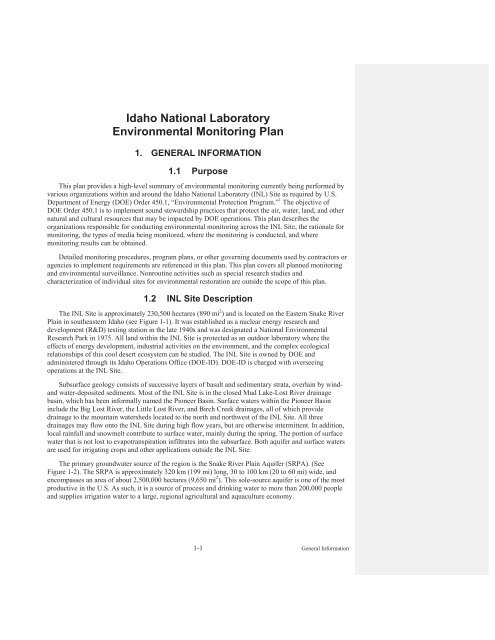Idaho National Laboratory Environmental Monitoring Plan
Idaho National Laboratory Environmental Monitoring Plan
Idaho National Laboratory Environmental Monitoring Plan
You also want an ePaper? Increase the reach of your titles
YUMPU automatically turns print PDFs into web optimized ePapers that Google loves.
<strong>Idaho</strong> <strong>National</strong> <strong>Laboratory</strong><br />
<strong>Environmental</strong> <strong>Monitoring</strong> <strong>Plan</strong><br />
1. GENERAL INFORMATION<br />
1.1 Purpose<br />
This plan provides a high-level summary of environmental monitoring currently being performed by<br />
various organizations within and around the <strong>Idaho</strong> <strong>National</strong> <strong>Laboratory</strong> (INL) Site as required by U.S.<br />
Department of Energy (DOE) Order 450.1, “<strong>Environmental</strong> Protection Program.” 1 The objective of<br />
DOE Order 450.1 is to implement sound stewardship practices that protect the air, water, land, and other<br />
natural and cultural resources that may be impacted by DOE operations. This plan describes the<br />
organizations responsible for conducting environmental monitoring across the INL Site, the rationale for<br />
monitoring, the types of media being monitored, where the monitoring is conducted, and where<br />
monitoring results can be obtained.<br />
Detailed monitoring procedures, program plans, or other governing documents used by contractors or<br />
agencies to implement requirements are referenced in this plan. This plan covers all planned monitoring<br />
and environmental surveillance. Nonroutine activities such as special research studies and<br />
characterization of individual sites for environmental restoration are outside the scope of this plan.<br />
1.2 INL Site Description<br />
The INL Site is approximately 230,500 hectares (890 mi 2 ) and is located on the Eastern Snake River<br />
Plain in southeastern <strong>Idaho</strong> (see Figure 1-1). It was established as a nuclear energy research and<br />
development (R&D) testing station in the late 1940s and was designated a <strong>National</strong> <strong>Environmental</strong><br />
Research Park in 1975. All land within the INL Site is protected as an outdoor laboratory where the<br />
effects of energy development, industrial activities on the environment, and the complex ecological<br />
relationships of this cool desert ecosystem can be studied. The INL Site is owned by DOE and<br />
administered through its <strong>Idaho</strong> Operations Office (DOE-ID). DOE-ID is charged with overseeing<br />
operations at the INL Site.<br />
Subsurface geology consists of successive layers of basalt and sedimentary strata, overlain by windand<br />
water-deposited sediments. Most of the INL Site is in the closed Mud Lake-Lost River drainage<br />
basin, which has been informally named the Pioneer Basin. Surface waters within the Pioneer Basin<br />
include the Big Lost River, the Little Lost River, and Birch Creek drainages, all of which provide<br />
drainage to the mountain watersheds located to the north and northwest of the INL Site. All three<br />
drainages may flow onto the INL Site during high flow years, but are otherwise intermittent. In addition,<br />
local rainfall and snowmelt contribute to surface water, mainly during the spring. The portion of surface<br />
water that is not lost to evapotranspiration infiltrates into the subsurface. Both aquifer and surface waters<br />
are used for irrigating crops and other applications outside the INL Site.<br />
The primary groundwater source of the region is the Snake River Plain Aquifer (SRPA). (See<br />
Figure 1-2). The SRPA is approximately 320 km (199 mi) long, 30 to 100 km (20 to 60 mi) wide, and<br />
encompasses an area of about 2,500,000 hectares (9,650 mi 2 ). This sole-source aquifer is one of the most<br />
productive in the U.S. As such, it is a source of process and drinking water to more than 200,000 people<br />
and supplies irrigation water to a large, regional agricultural and aquaculture economy.<br />
1-1 General Information
















